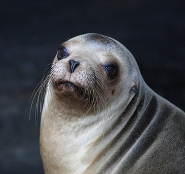 The Galapagos fur seal (Arctocephalus galapagoensis) is one of the smallest eared seals and is only 1 1/2 meters in length (4.5 feet) and they generally weigh just under 64 Kilograms (141 lbs). These seals have a brownish coat and are found in the Galapagos Island Chain, just west of Ecuador. Though they were once completely endemic to this island chain, colonies of Galapagos fur seals have been established around the world by the Organization for Research and Conservation. As a result, they can now be found as far north as Peru.
The Galapagos fur seal (Arctocephalus galapagoensis) is one of the smallest eared seals and is only 1 1/2 meters in length (4.5 feet) and they generally weigh just under 64 Kilograms (141 lbs). These seals have a brownish coat and are found in the Galapagos Island Chain, just west of Ecuador. Though they were once completely endemic to this island chain, colonies of Galapagos fur seals have been established around the world by the Organization for Research and Conservation. As a result, they can now be found as far north as Peru.Galapagos fur seals have a diet that consists of mainly fish and cephalopods, with their dietary preferences centering mainly around the Galapagos reef octopus and Broadclub Cuttlefish. The hunting duties of the colony are delegated to the female of the species and each female assumes a territory that is a satellite of the larger fur seal colony. The female will use this territory to hunt for food and breed her pups. Seal pups will nurse for approximately two years before they head off on their own and establish their own territories.
The food supply for Galapagos fur seals are plentiful for most years. This changes during an El Nino season, however. This is because an El Nino causes the waters around the islands to warm dramatically, thus driving their primary prey to cooler waters.
What makes the Galapagos fur seal so unique and distinguishable from other seal species is its lush coat. The fur coats of this species are fuller and thicker than other species, giving them the ability to dive to extraordinary depths, even in very cold waters. It also enables them to withstand temperatures below freezing, making them one of the most insulated animals in the Galapagos Island Chain. Unfortunately, their characteristic fur coat is also almost what drove them to extinction. During the late nineteenth century, these seals were extensively hunted for their fur coats, which were highly prized in the United States and Europe. In recent years this trend has been reversed and the Galapagos fur seal population is once again vibrant and healthy.
Picture of the Galapagos fur seal by Andy Jones (original), licensed under Attribution-NonCommercial-ShareAlike 2.0 Generic (CC BY-NC-SA 2.0)
The Galapagos islands fur seal, galápagos fur seal is listed as Vulnerable (VU), considered to be facing a high risk of extinction in the wild, on the IUCN Red List of Threatened Species
Namings for the Gal
A young / baby of a Gal is called a 'pup'. The females are called 'cow' and males 'bull'. A Gal group is called a 'pod, colony, crash, flock, harem, bob, herd, rookery, team or hurd'.Countries
EcuadorGalápagos fur seal habitats
Marine Coastal / Supratidal, Marine Intertidal, Marine Neritic, Pelagic, Rocky Shoreline, Sandy Shoreline and / or Beaches, Sand Bars, Spits, Etc and Sea Cliffs and Rocky Offshore IslandsSome facts about the
Southern fur seal
Adult weight : 45.5 kg (100.1 lbs)
Female maturity :1461 days
Gestation : 213 days
Weaning : 776 days
Litter size : 1
Litters per year : 1
Interval between litters : 365 days
Weight at birth : 3.5 kg (7.7 lbs)
Weight at weaning : 15 kg (33 lbs)

Custom Search